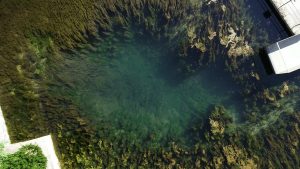A master of disposal
During every summer walk on the sandy paths of the Senne you will come across one or more spring dung beetles (Geotrupes vernalis). Since it is practically always moving on the ground, the bright blue coloured beetle is immediately noticeable. In flight it looks rather ungainly and clumsy; however, as soon as a dung beetle has landed on a dung heap, e.g. from a horse, it becomes very active. In a few minutes, balls 4-5 cm in size are formed from the manure, which are then buried in the sand and covered with an egg. The beetle larvae feed on their supply and pupate after about 10 months in the ground. When shaping and burying the ball of excrement, the beetles use their serrated front legs, which serve as powerful digging shovels. They often carry numerous red mites with them on the underside. The beetles use these as a means of transport to get to a fresh dung heap.







